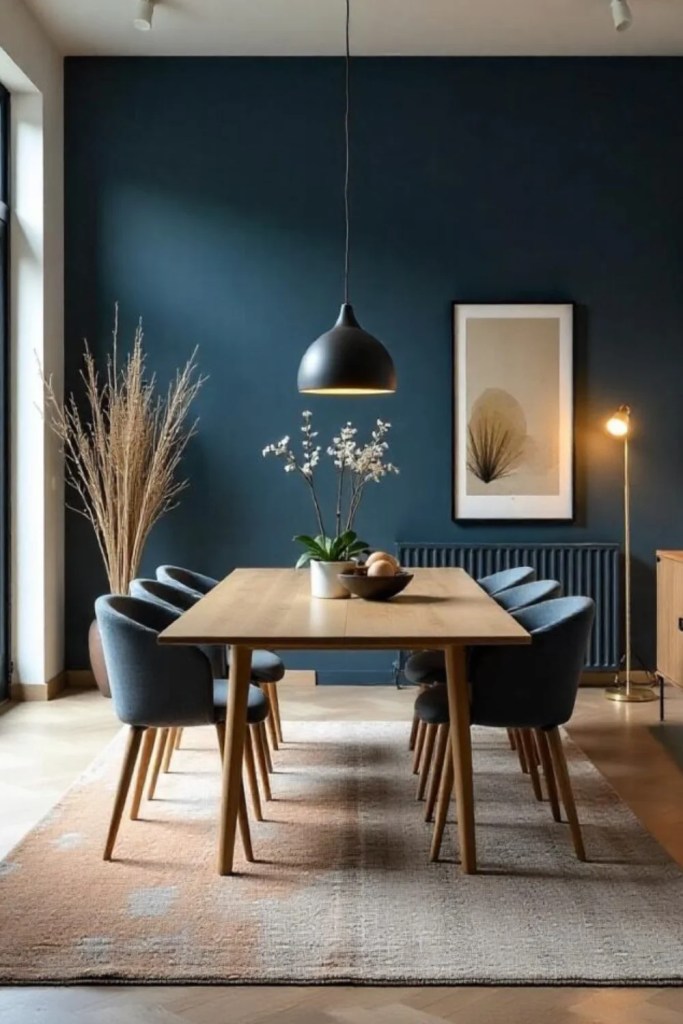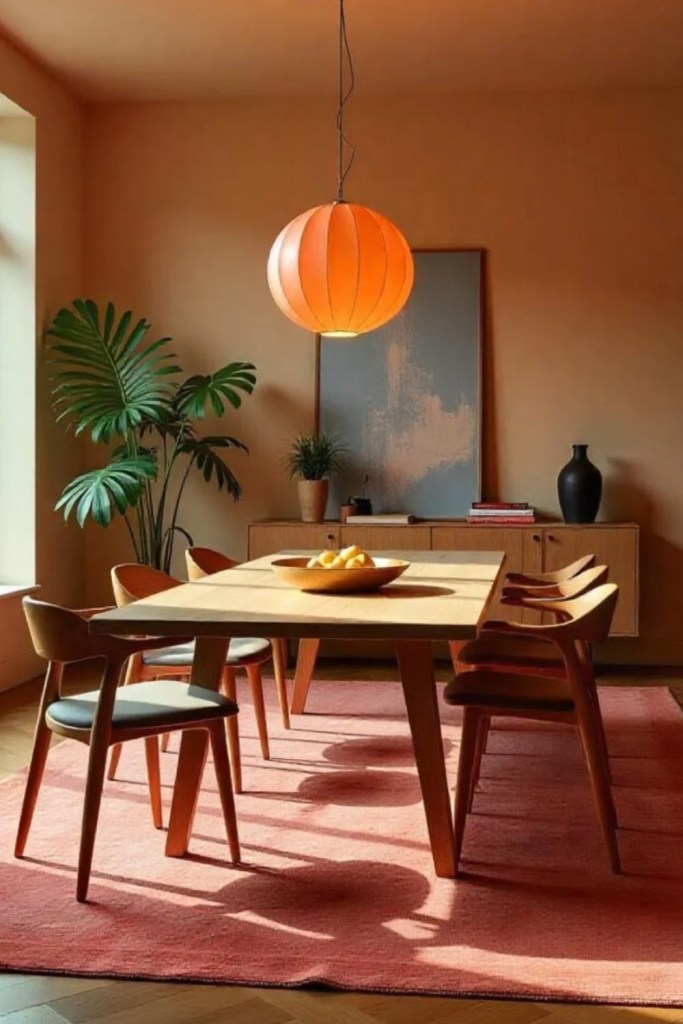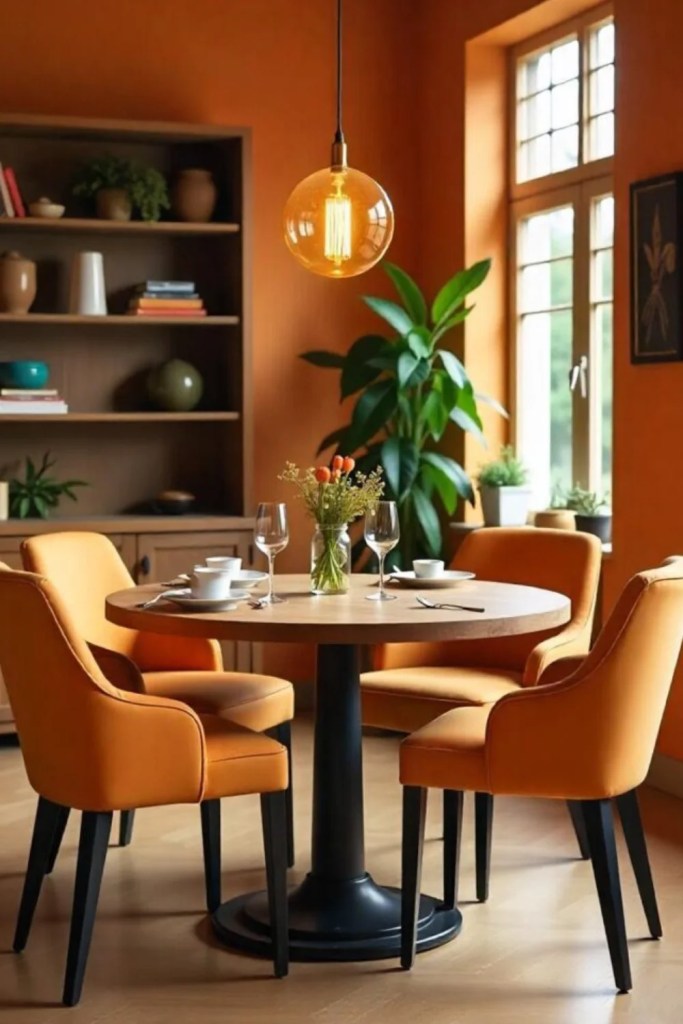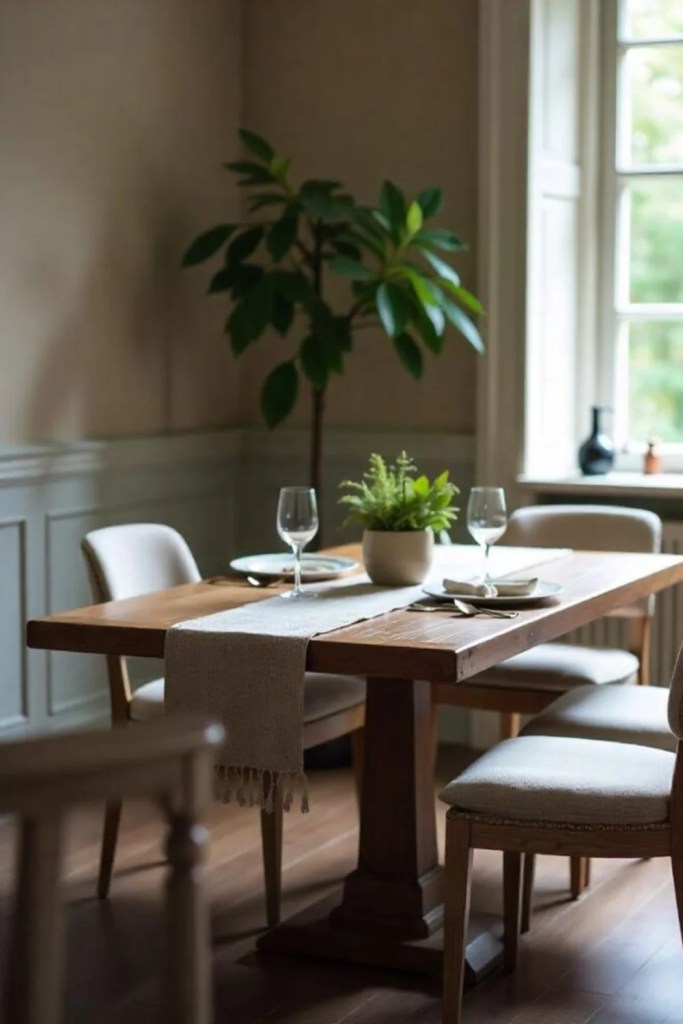
From a cozy, intimate nook to a sprawling, open-plan loft, the dining room is the true heart of the home. It’s more than just a place to eat; it’s the stage for life’s best moments, the quiet family dinners, the loud celebratory feasts, the intense board game battles, and the long, heartfelt conversations. It’s where memories are made, gossip is exchanged, and connections are strengthened.
The good news? You don’t need a massive renovation or a furniture-store budget to make this space shine. Sometimes, the smallest, most sensible adjustments, the kind an interior design expert would recommend can make the most dramatic difference.
A well-designed dining room should be practical, stylish, and welcoming. If you’re ready to enhance your dining room and transform it into your home’s favorite spot, you’ve come to the right place. We’ve gathered seven expert tips that will help you create a dining space that is not only functional and beautiful but also deeply comforting.
1. Get the Dimensions Right: Why Table Width Matters

When you envision a perfect dinner party, what do you see? People chatting easily, wine flowing, and plates artfully arranged. This vision is heavily dependent on one crucial detail most people overlook: table width.
The table is the undisputed star of the dining room. Its size and shape set the tone for the entire space, but width is particularly critical for functionality and comfort.
The Magic Number: 43 Inches
Experts often suggest that 43 inches (about 110 cm) is the ideal width for a standard dining table. Why this specific number?
- Ideal Table Settings: This width provides enough real estate for full table settings for diners on both sides—plates, cutlery, glassware, and napkins.
- The Center Stage: Crucially, it leaves a generous central strip for all the wonderful things that make a dinner memorable: large serving platters, elaborate floral centerpieces, decorative candles, wine bottles, and water pitchers.
- Social Comfort: With a 43-inch width, diners are close enough to hear and engage easily with the person across from them without feeling cramped, yet far enough away that they aren’t accidentally kicking feet or reaching across one another awkwardly. It strikes the perfect balance for comfortable socialization.
What Happens When the Table Is Too Narrow?
A table that is too narrow (e.g., less than 36 inches) forces a frustrating compromise. You have to choose between a comfortable place setting and space for serving dishes. Guests often feel crowded, and the table can quickly look chaotic and cluttered.
What Happens When the Table Is Too Wide?
While a wide table might seem luxurious, going significantly over 48 inches can make conversation difficult. Guests may have to raise their voices or lean forward to hear, which destroys the intimate, relaxed ambiance you’re aiming for when you enhance your dining room.
Key Takeaway: Before you buy, measure your space and commit to a width that supports both food and conversation. It’s the foundational step to enhance your dining room experience.
2. Define the Space: The Anchoring Power of Rugs

In open-plan layouts, or even in large, undivided dining rooms, your beautiful table and chairs can sometimes feel a bit lost, floating in a sea of flooring. This is where a strategically placed rug comes in.
A rug is the simplest and most effective way to define the dining space, grounding the furniture and creating a visual “room within a room.” But the placement and size have to be precise.
The Golden Rule of Rug Dimensions
To properly anchor your dining set, the rug must be large enough to accommodate all four chair legs even when the chairs are pulled out and occupied.
The simple, essential rule is this: The rug needs to be at least 23.5 inches (about 60 cm) wider than the table on all sides.
- Example: If your table is 72 inches long, your rug should be at least 72+23.5+23.5=119 inches long.
- Practicality First: This extra space prevents the irritating snag where a chair leg catches on the edge of the rug every time a diner stands up or sits down. A chair should glide smoothly on the rug without dragging the edge.
Choosing the Right Rug Material
When you enhance your dining room, remember that this area sees spills, crumbs, and heavy traffic.
- Durability: Opt for durable, easy-to-clean materials. Wool, synthetic blends (like polypropylene), and low-pile rugs are excellent choices.
- Avoid: Steer clear of shaggy, high-pile rugs, as they are a nightmare to clean and trap crumbs easily. Silk or very delicate fibers are best reserved for lower-traffic areas.
- Color/Pattern: A rug with a busy pattern can be your best friend, as it cleverly disguises the inevitable minor stain until you get a chance to clean it properly.
3. Don’t Overlook Height: The Comfort Quotient

In the world of dining room design, the difference between an elegant seating arrangement and an uncomfortably awkward one often comes down to millimetres of height.
This is particularly relevant for those who love the eclectic style a beautiful trend that involves mixing an old vintage table with sleek, modern chairs, or pairing a hand-me-down heirloom with newly upholstered seating.
Measure Twice, Sit Once
When combining pieces from different eras or different suppliers, you run a risk of mismatching heights. Imagine a scenario where:
- The table is too low for the chairs, forcing diners to hunch over.
- The chairs are too short for the table, making guests feel like children reaching up to the plates.
- The armrests (if any) are too high to slide neatly under the table, forcing chairs to stick out awkwardly.
The Standard Comfort Zones
While designs vary, here are some typical comfort measurements to keep in mind:
- Table Height: Standard height is typically between 28 and 30 inches.
- Chair Seat Height: Standard chair seat height is typically between 17 and 19 inches.
- The Crucial Gap: There should be a gap of about 10 to 12 inches between the top of the chair seat and the underside of the table apron (the wooden frame connecting the legs). This is the minimum comfortable space needed for a person’s thighs.
If you are committed to mixing and matching, you must commit to accurately measuring all pieces beforehand. Don’t guess. A little precision ensures the height difference isn’t just stylish, but genuinely comfortable for you and your diners.
4. Layout and Flow: The Advantage of a Round Table

While rectangular tables are the most common choice, especially for seating large groups, a round table offers distinct advantages, particularly when you want to enhance your dining room‘s flow and interaction.
Better Flow of Traffic
In open-plan layouts or smaller, more constrained spaces, a round table is a champion for movement.
- No Sharp Corners: The absence of rigid, sharp corners means people can navigate around the table without bumping into an obstacle. It creates a smoother, more organic flow of traffic from the kitchen to the living area.
- Visual Softness: If the rest of your dining room furniture or architecture flaunts more linear, rigid designs (straight-backed cabinetry, rectangular windows, etc.), a round table provides a beautiful, soft contrast, making the space feel less severe and more welcoming.
Enhanced Conversation and Intimacy
Round tables are inherently more egalitarian and intimate.
- Everyone is Equal: Unlike a rectangular table, where the ‘head’ seats can feel more formal, a round table places everyone at the same distance, fostering a sense of shared community.
- Easy Conversation: Guests can see and talk to everyone else at the table without straining their neck or having to lean around centerpieces. This promotes better interaction and keeps the conversation lively and inclusive.
Size Matters for Rounds
The drawback to round tables is that they take up a surprisingly large amount of floor space for the number of people they seat. To maximize their benefits, be sure to select a size that doesn’t overwhelm the room.
5. Lighting is Essential: Setting the Perfect Ambiance

Nothing can spoil a fantastic meal faster than harsh, glaring, or inadequate lighting. The key to a calming, sophisticated dining ambiance is great lighting specifically, well-considered layers of light.
When you seek to enhance your dining room, think of lighting as jewelry for the space, not just a utility.
The Focal Point: Pendant Lighting
Pendant lighting (or a chandelier) hung directly over the table is the most popular and effective choice.
- Decorative Design Element: A stunning pendant acts as a major focal point, drawing the eye and adding a high level of decorative design. It establishes the table as the center of the room.
- Task and Ambiance: It provides direct light where you need it most (on the food and faces) while keeping the surrounding room in a softer, more atmospheric glow.
The Crucial Height of Pendants
The height of your pendant is vital for function and comfort:
- The Rule of 30–36: The bottom of the light fixture should typically hang about 30 to 36 inches above the tabletop.
- Avoid the Glare: If it’s too high, it loses impact. If it’s too low, it blocks the view of the person across the table and may cause an annoying glare in diners’ eyes.
The Warmth of Dimming
Remember, you don’t typically spend a lot of time working or reading in the dining room, so the light shouldn’t be too harsh or bright.
- Dimmers are Non-Negotiable: Every dining room light fixture should be on a dimmer switch. This allows you to easily transition the ambiance bright for a midday brunch, soft and warm for an intimate evening dinner party.
- Color Temperature: Choose bulbs with a warm color temperature (around 2700K to 3000K) to give food and faces a healthy, inviting glow. Cooler, bluer lights (4000K+) are best for offices or kitchens, not for socializing.
6. Add Interest and Character: The Conversation Starters

A common mistake in design is treating the dining room as purely utilitarian. The table and chairs are there, the food is served, end of story. But a truly wonderful dining room, one you’ve worked hard to enhance your dining room appeal, is a room with character, just like a living room or bedroom.
You need to add a few touches that ensure interest, spark conversation, and reflect your personality.
Wall Art and Decor
What are you planning on talking about while hosting your next dinner party? Give your guests something to look at and discuss!
- Eye-Catching Painting: A large, expressive piece of art on a wall near the table can be a fabulous focal point. It can set the color palette for the entire room.
- Statement Mirrors: Mirrors not only add visual interest but also bounce light around the room, making it feel brighter and larger.
- Architectural Features: A handsome cabinet or sideboard can display treasured ceramics, glassware, or a beautiful collection of books.
Beyond the Table
The accessories on and around the table are just as important as the furniture itself.
- Stunning Lighting Fixtures: As mentioned, your pendant light can be a sculptural piece of art it’s the perfect spot to splurge on a ‘wow’ factor.
- Tabletop Centerpieces: Rather than always relying on flowers, consider unique, low-profile centerpieces: a bowl of polished stones, a collection of interesting glass vessels, or a grouping of varying height pillar candles.
- Seasonal Touches: Rotate your decor seasonally (fall gourds, spring greenery) to keep the space feeling fresh and dynamic.
Adding interest ensures that the dining table is truly more than just a space for eating it’s a curated experience.
7. Texture and Warmth: The Sensory Experience

Speaking of adding charm to your dining room, let’s talk about the sensory experience: texture and warmth. A room that lacks varied texture can feel flat, sterile, and cold. A room rich in texture feels layered, cozy, and inviting.
When you work to enhance your dining room, consider how all the different pieces, textures, and patterns will influence the final design.
Layering Textures for Depth
Don’t be afraid to play with different materials, finishes, and sheen to make your dining room stand out.
- The Wood of the Table: Is your dining table made of a richly textured, rustic wood with visible grain, or is it a smooth, high-gloss veneer? The choice sets the mood.
- Seating Comfort: What about the chairs? Do they have soft, plush upholstered fabrics, or are they sleek, hard metal and wood? Adding simple, tie-on cushions can instantly add warmth, color, and comfort.
- The Rug’s Hand: Is your rug a flat weave, or does it have a soft pile? Is it a natural jute or a thick, patterned wool?
- Wall Treatments: Beyond paint, consider textured wallpaper, wainscoting, or exposed brick to add a layer of complexity to the vertical space.
The Power of Soft Furnishings
The most accessible way to introduce warmth is through textiles.
- Drapes: Heavy, lined drapes or curtains add instant softness and acoustic dampening, making the room feel quieter and cozier.
- Table Linens: A beautiful tablecloth, fabric placemats, or linen napkins immediately elevate the formality and warmth of the setting.
- Throws/Blankets: If your dining room is part of an open-plan living space, having a stylish throw draped over an accent chair adds a touch of residential comfort.
By playing with these elements, you create a tactile, visually engaging space that begs people to sit down, stay awhile, and feel completely at ease.
Final Thoughts on Dining Room Enhancement
There’s no need for a massive, disruptive change to make your dining room beautiful and attractive. The truth is, just a few small but sensible changes—the kind you can implement this weekend can make the space truly special.
Paying attention to the practical details like table width and height ensures comfort. Defining the space with an appropriately sized rug and setting the mood with soft, dimmable lighting creates an elegant decor. And focusing on texture, warmth, and conversation-starting details adds the unique, personal character that transforms a simple eating area into a truly welcoming palace where every meal is sure to delight.
With a little thoughtful hard work and a dash of personal flair, you can enhance your dining room to be not only comfortable but everyone’s favorite place to gather. Your dining room will be one of the prettiest and most functional rooms in the house.



